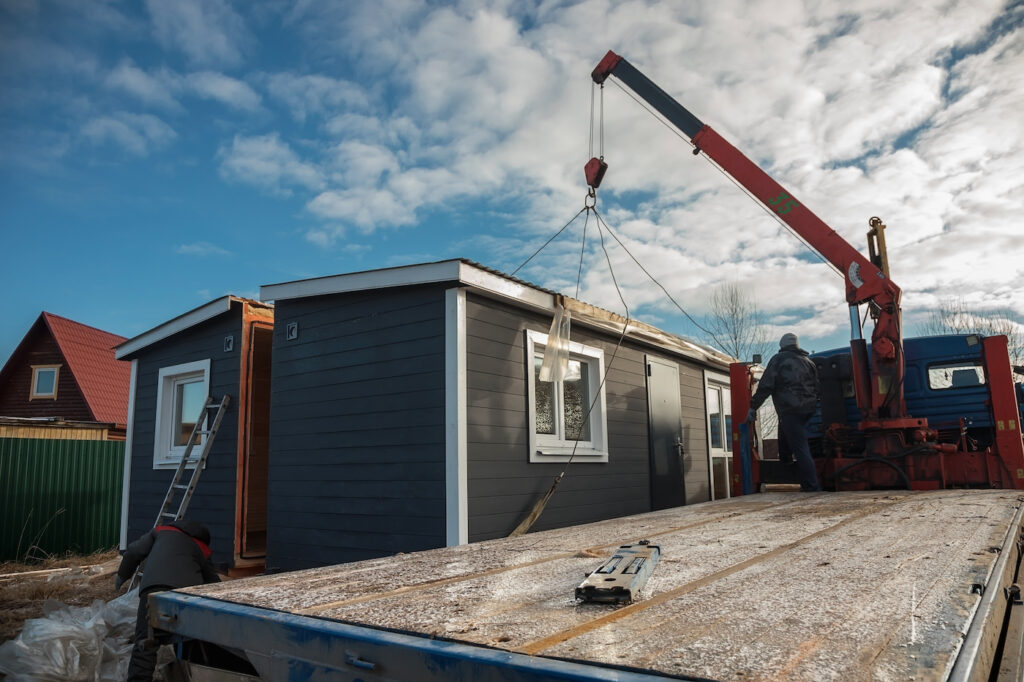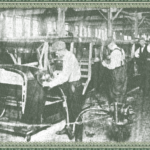This essay is the second in a three-part symposium on housing and family. Read the first here.
Conservatives have big dreams for the family. Some conservatives are calling for a return to pre-industrial family models: they reject both the second wave feminist “bio-libertarian” model, which centers on autonomy and career accomplishment, and the faux conservative 1950s housewife model, which centers around men working while their wives stay home, bake cookies, and raise kids. The current status quo, a mishmash of both models, has produced sub-replacement fertility and epic levels of loneliness.
Returning to older family forms could help reverse those trends. Some options include home-based economic production, intergenerational households, and micro-level community along the lines of traditional villages, neighborhoods, and congregations.
These ideas are promising, but any significant improvements to American family life will require corresponding improvements to the US housing stock. Young Americans cannot afford decent houses, let alone houses big enough to fit all of the kids they want to have, so they are naturally not marrying and not having enough kids to replace themselves. Those who do marry get the reward of living in suburbia, which is lonely, especially for mothers taking care of young kids.
Start your day with Public Discourse
Sign up and get our daily essays sent straight to your inbox.Fortunately, conservatives have some levers they can pull to address these problems. Their best options are lowering mortgage interest rates and changing federal and state regulations to allow manufactured housing, which is significantly cheaper, quicker to build, and more flexible than traditional housing. Manufactured housing could also address the loneliness crisis plaguing many Americans: it is an ideal mechanism for realizing more social, less atomizing family arrangements better suited to twenty-first-century life.
America’s Housing Landscape Today
Like much of American culture, America’s housing debates seems frozen in the 1960s, polarized along the lines of that decade’s culture war.
In cities, which lean progressive, multi-family apartment blocks and condos reign supreme. Progressives have favored dense housing arrangements since the Woodrow Wilson era, but the rise of climate alarmism gave this project new urgency: unless most people are crowded into apartment blocks, they will keep driving cars and emitting greenhouse gases. Unfortunately, apartment living is challenging for families of any size, and it works best for single people, poor people who cannot afford breathing space, and rich people who can outbid others for breathing space. Everyone else usually flees to the suburbs, especially if they have a crying baby in tow (or two or three).
Progressives extol the virtues of dense apartment blocks and decry “single-family zoning” and “car-dependent development.” However, they have also stymied housing development in blue cities with needlessly restrictive environmental and land-use policies. This has virtually ensured that the dense apartment blocks progressives hail as the only sustainable housing model for the future will not actually predominate in the future.
On the opposite end of the political spectrum, conservatives continue to build and live in 1950s-style suburban houses, spaced out like saguaro cacti with intervening strips of America’s favorite irrigated crop: lawn. The modern suburb was co-invented by the federal government and real estate developers like William Levitt. Levitt used standardization and mass-production techniques to dramatically decrease the cost of new homes, which, coupled with federal financing, made homeownership available on an unprecedented scale in the wake of World War II. This blueprint is still in place today: the United States had roughly 83 million single-family homes in 2018, more than 80 percent of which were owner-occupied.
The initial rise of suburban living in the 1950s cut women off from the relationships and productive activities that had filled women’s lives in earlier eras; their discontent fueled the second-wave feminism of the 1960s.
Unfortunately, many of these homes are repetitive and architecturally uninspiring, though some upscale versions are almost elegant. More importantly, suburban housing contributes to loneliness and atomization, especially for women raising kids at home. The initial rise of suburban living in the 1950s cut women off from the relationships and productive activities that had filled women’s lives in earlier eras; their discontent fueled the second-wave feminism of the 1960s. Even today, the loneliness of suburban stay-at-home motherhood makes motherhood in general seem less appealing to many women.
A Better Future: Manufactured Housing
How can Americans emerge from this gridlock? One important but underused option is manufactured housing. Like everything else, housing is much cheaper when mass-produced. The traditional way of building houses is to construct them individually on-site, often largely by hand, which requires lots of skilled labor and time: compare assembling Honda Accords in factories to assembling them piece-by-piece in each customer’s driveway. Factory produced housing is about 50 percent cheaper than traditionally built housing, a potentially life-changing discount for middle- and lower-income families.
Modular housing could help make multigenerational living a more desired living arrangement, even for families who are not financially struggling.
Manufactured housing also can be modular and flexible, helping families move away from the nuclear-family-only model and toward less conventional arrangements. Imagine ordering a bedroom and kitchen online for your mother-in-law, then plopping it in your backyard—or, if you prefer, on top of your current house as a second story. Americans have already been slowly reverting back to multigenerational living arrangements since the suburban 1950s, but this trend has been driven by financial difficulty and prolonged bachelorhood rather than cultural preferences: see the rise of the basement millennial. Modular housing could help make multigenerational living a more desired living arrangement, even for families that are not financially struggling.
Manufactured housing developers realized some of these efficiencies and had a brief golden age in the 1950s and 1960s. At the industry’s peak, roughly 60 percent of new housing units in the United States were factory-made, and “mobile” home parks spread across America. However, pretty much all cities banned new mobile home parks in the 1970s, spurred partly by traditional homebuilders and other aligned interest groups. Traditional homebuilders, through their national association, also convinced the federal government to exclude manufactured housing from federal home financing programs and imposed onerous regulations on the industry, causing it to collapse in the 1970s. Today, manufactured homes comprise only around 10 percent of new housing units produced, and virtually all of them are placed in pre-1975 mobile home parks or in rural areas such as Indian reservations.
Affordability
Even more than flexibility, housing affordability is the key to helping family life thrive. History attests to this: cheap housing helped facilitate the postwar baby boom. But young families today face a different reality. The cost of housing since 1985 has roughly tripled according to the think tank American Compass. Only 21 percent of homes for sale in 2022 were affordable according to a survey, from real estate broker Redfin, which defined “affordable” as having a monthly mortgage payment below 30 percent of the local median household income. Using that same 30 percent threshold, roughly 46 percent of American renters are paying too much rent. By now, every policymaker can see the flashing red lights telling them that “inflation,” or more accurately cost of living, is a major problem for low- and middle-income Americans. Housing, most families’ biggest single expense, is a great place to start.
A key way to make housing more affordable is to bring rationality to federal housing policy, such as by charging less interest on home loans. There is no iron law of the universe that says governments have to charge the prevailing market interest rate on loans: they can—and should—charge less sometimes, earning returns for taxpayers while advancing other policy goals at the same time. Government-backed, sub-market-rate loans helped China scale up its industrial base, for instance. This kind of government aid would not be new in the United States: government-backed, sub-market-rate student loans also helped the US government scale up the total share of Americans earning college degrees (albeit with questionable return-on-investment for the rest of society).
College degrees need not be universal, but decent housing should be, so there’s arguably more justification for government housing aid than for government student loans. The current interest rate on thirty-year mortgages is roughly 7 percent; it would make sense for the federal government to back loans charging half that (3.5 percent) for the first $200,000 of every mortgage to encourage homeownership. The government could also take a cue from Hungary’s Viktor Orbán and tie mortgage interest rates to marriage, arguably the most important driver of birth rates. The US government did something similar in the 1950s: World War II vets received artificially low mortgage rates as part of their benefit package, encouraging them to get married and have kids relatively young. The United States still offers veterans lower mortgage interest rates, but the absence of world wars since 1945 has reduced the number of young families able to take advantage of this option.
Opening up homeownership and cutting mortgage payments for millions of Americans would be great politics: putting money into people’s wallets is a perennial vote-winner.
The Wall Street lobby would fight this, of course: cheap federal financing would undercut private mortgage lending, costing banks money. Homebuilders would fight this even harder: including manufactured housing in federal mortgage lending programs on equal terms with traditional housing would put many traditional homebuilders out of business. Other rational reforms to the federal mortgage regime, such as eliminating the unhelpful and regressive $70 billion mortgage interest rate tax deduction, would trigger fights of their own. But opening up homeownership and cutting mortgage payments for millions of Americans would be great politics: putting money into people’s wallets is a perennial vote-winner.
American Dreams and Delusions
The leading Republican nominee at the time of this writing seems to be Donald Trump, and the centerpiece of his 2024 campaign is his “Freedom Cities” proposal. Trump wants to build 10 new cities on federal land, featuring newly reshored jobs from China, Orbán-esque baby bonuses, and even flying cars. Overall, this package of ideas reflects Trump’s populist intuitions more than any sort of serious planning.
Flying cars for everyone may not be realistic, but the old Jeffersonian idea of “a little land for everyone” certainly is. Thriving, socially connected families require decent houses, so helping families thrive and connect with others should include helping all of them own decent homes. Rational regulation and basic mass production techniques can help make that American dream a reality.














